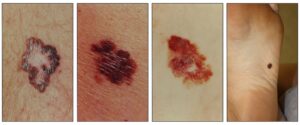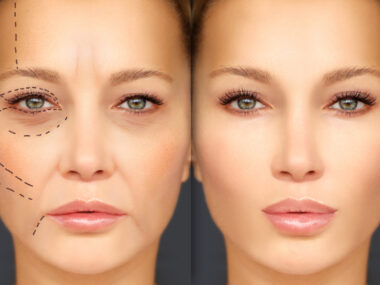Skin cancer is one of the most prevalent types of cancer globally, with millions of cases diagnosed each year. It occurs when abnormal skin cells grow uncontrollably, forming tumours or lesions that can be malignant (cancerous) or benign (non-cancerous).
Understanding the relationship between abnormal skin growth and cancer development is crucial for early detection, treatment, and prevention efforts.
In this essay, we will explore the underlying causes of abnormal skin growth, the different types of skin cancer, risk factors, and strategies for prevention and detection.
Abnormal Skin Growth
Abnormal skin growth refers to the proliferation of skin cells that deviate from the normal growth and repair processes of the skin. While some forms of abnormal growth are harmless, others can be precursors to skin cancer or indicative of malignancy.
Abnormal growths may manifest as changes in the size, shape, colour, or texture of moles, lesions, or other skin abnormalities. These changes can be subtle or dramatic and may occur suddenly or over time.
The relationship between abnormal skin growth and cancer development lies in the transformation of normal skin cells into cancerous cells. This transformation can occur due to genetic mutations, environmental factors, or a combination of both.
Types of Skin Cancer
The most common types of skin cancer include basal cell carcinoma (BCC), squamous cell carcinoma (SCC), and melanoma.
- Basal cell carcinoma (BCC) is the most common type of skin cancer, accounting for approximately 80% of all cases. It typically develops in areas of the skin exposed to the sun, such as the face, neck, and hands. BCC usually appears as a flesh-coloured or pink bump with a pearly or waxy texture. While BCC rarely metastasizes (spreads) to other parts of the body, it can cause significant local tissue damage if left untreated.

- Squamous cell carcinoma (SCC) is the second most common type of skin cancer, accounting for approximately 20% of cases. It also primarily affects sun-exposed areas of the skin and may present as a red, scaly patch or a firm, raised bump. SCC has a higher potential for metastasis compared to BCC, particularly if left untreated or if it arises on the lips, ears, or genital area.
- Melanoma is the most aggressive form of skin cancer, although it accounts for only a small percentage of cases. Melanoma develops from melanocytes, the pigment-producing cells in the skin, and can arise from existing moles or as new lesions. Melanoma often presents as an asymmetric, irregularly shaped mole with uneven borders and multiple colours. It has the highest potential for metastasis and can spread rapidly to other parts of the body if not detected and treated early.
The underlying causes of abnormal skin growth and skin cancer development are multifactorial, involving a combination of genetic predisposition, environmental exposures, and lifestyle factors.
Ultraviolet (UV) radiation from the sun or artificial sources, such as tanning beds, is a major risk factor for skin cancer. UV radiation damages the DNA in skin cells, leading to mutations that can trigger abnormal growth and cancer development over time.
Other risk factors for skin cancer include:
- Fair skin, light hair, and blue or green eyes, which are more susceptible to UV damage
- History of sunburns or excessive sun exposure, especially during childhood or adolescence
- Family history of skin cancer or genetic syndromes associated with increased cancer risk
- Weakened immune system due to conditions such as HIV/AIDS or immunosuppressive medications
- Previous history of skin cancer or precancerous skin lesions
Prevention and early detection are critical in reducing the incidence and impact of skin cancer. Strategies for prevention include:
- Limiting sun exposure, especially during peak hours (10 a.m. to 4 p.m.), and seeking shade when outdoors
- Wearing protective clothing, including wide-brimmed hats, long sleeves, and sunglasses
- Applying broad-spectrum sunscreen with SPF 30 or higher to exposed skin, and reapplying every two hours or after swimming or sweating
- Avoiding indoor tanning beds and sunlamps, which emit harmful UV radiation
- Performing regular skin self-exams to monitor for changes in moles, lesions, or other skin abnormalities
Early detection of skin cancer is crucial for successful treatment and improved outcomes. Dermatologists recommend performing monthly skin self-exams to check for new or changing lesions, using the ABCDE rule to identify signs of melanoma:
- Asymmetry: One half of the mole or lesion does not match the other half
- Border irregularity: The edges are uneven, scalloped, or poorly defined
- Color variation: The mole or lesion has multiple colours or shades, including black, brown, tan, red, white, or blue
- Diameter: The size of the mole or lesion is larger than the size of a pencil eraser (6 mm)
- Evolution: The mole or lesion changes in size, shape, colour, or texture over time
If you notice any suspicious changes in your skin, such as new growths, changes in moles, or persistent sores that do not heal, it is essential to consult a dermatologist for evaluation and diagnosis. Dermatologists can perform a comprehensive skin examination, including a full-body skin check and, if necessary, a biopsy to confirm or rule out skin cancer.
Conclusion
The relationship between abnormal skin growth and cancer development underscores the importance of vigilance, prevention, and early detection in reducing the burden of skin cancer.
By understanding the risk factors, signs, and symptoms of skin cancer, individuals can take proactive steps to protect their skin health and seek timely medical attention if abnormalities arise.
Through sun protection, regular skin self-exams, and routine skin cancer screenings, we can work together to prevent and detect skin cancer at its earliest stages, ultimately saving lives and preserving quality of life.
Related Tags
Taiwo Olawuyi
Taiwo Olawuyi is a highly dedicated and passionate professional blogger, renowned for her ability to create captivating, informative, and engaging content in the realm of health and wellness. She holds a Bachelor's degree in Political Science from Olabisi Onabanjo University and a Master's degree in Adult Education from the prestigious University of Ibadan. Her profound passion for health and wellness, coupled with her unwavering dedication to her audience, serves as a constant source of inspiration and enlightenment for readers worldwide.










